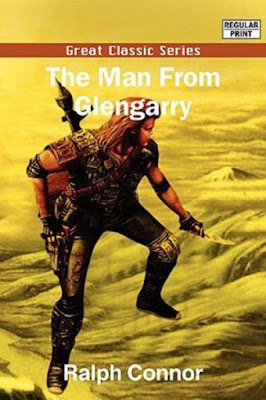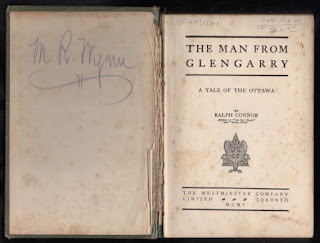Late last month, I was interviewed by CULT MTL for their cover story on Montreal pulp and the Ricochet Books series. The issue arrived on the stands last week. Since then, I've been contacted by a number of people wanting a list of Montreal's post-war pulps. The only one of which I knew was this 2014 list made for my Canadian Notes & Queries column. I think it has stood the test of time – two years, anyway – but am now wondering whether it shouldn't be expanded.
All depends on one's definition of "post-war," really. For the purposes of the column, I chose the ten years that followed the August 1945 armistice – though, truth be told, I see the period as ending in 1960. Am I wrong? Americans tend to agree... much to do with Kennedy's victory and that torch being passed to a new generation, I expect. Across the pond, certain cousins maintain that it all ended in 1979 when Thatcher moved into 10 Downing Street.
And then a great darkness set in.
This revised list covers pulps set in Montreal and published between the armistice and the end of 1960, the last day of the farthing. Links are provided for my reviews of each. Titles that have been revived as part of the Ricochet Books series are indicated with asterisks.
 The House on Craig Street
The House on Craig StreetRonald J. Cooke
Winnipeg: Harlequin, 1949
The first novel by magazine writer and editor Cooke, The House on Craig Street is about a kid who thinks he'll make a killing in the advertising game. He does, though this real passion is literature.
Love is a Long Shot
Alice K. Doherty [pseud. Ted Allan]
Toronto: News Stand Library, 1949
Allan's second novel – after the recently rereleased This Time a Better Earth – Love is a Long Shot is notable for containing the most disturbing scene in Canadian literature. I've written this before. I'll write it again. It haunts.
Sugar-Puss on Dorchester Street*
Al Palmer
Toronto: News Stand Library, 1949
Newspaperman Palmer's only foray into fiction. A slim novel written with tongue firmly in cheek, its value comes in its depiction of pre-Drapeau Montreal, a time when Dorchester was a street... and was called Dorchester.
The Mayor of Côte St. Paul*
Ronald J. Cooke
Winnipeg: Harlequin, 1950
Easily the best of Cooke's three novels. Heavily autobiographical, like the first, it follows aspiring writer Dave Manley, who joins a crime syndicate in quest of material.
Wreath for a Redhead
Brian Moore
Winnipeg: Harlequin, 1951
The very first novel by Moore, a man who would win two Governor General's Awards and be shortlisted for several Bookers.
"Montreal Means Murder!"
The Crime on Cote des Neiges*
David Montrose
[pseud. Charles Ross Graham]
Toronto: Collins White Circle, 1951
Montrose's debut introduces Montreal private dick Russell Teed. Here he's trying to prove the innocence of a Westmount girl accused of murdering her bootlegger husband.
The Executioners
Brian Moore
Winnipeg: Harlequin, 1951
Dangerous men arrive in Montreal tasked with either kidnapping or killing an exiled foreign leader. Mike Farrell, a veteran of the Second World War and more than a few boxing rings, sets out to stop them.
Flee the Night in Anger
Dan Keller [pseud. Louis Kaufman]
Toronto: Studio Publications, 1952
Unique amongst the post-war pulps, Flee the Night in Anger divides its action between Montreal and Toronto. Beware the 1954 American reprint, which cuts out a good quarter of the text (including the dirtiest bits).
Murder Over Dorval*
David Montrose
[pseud. Charles Ross Graham]
Toronto: Collins White Circle, 1952
The second Russell Teed book, Murder Over Dorval is set in motion when a Canadian senator is clubbed on the head during a particularly turbulent flight from La Guardia.
The Body on Mount Royal*
David Montrose
[pseud. Charles Ross Graham]
Winnipeg: Harlequin, 1953
The third and final Russell Teed adventure is also his booziest. This one involves blackmail, illegal gambling and, of course, a dame... two, in fact.
Intent to Kill
Bernard Mara [pseud. Brian Moore]
New York: Dell, 1956
The last of Moore's Montreal pulps. A thriller set in a building modelled on the Montreal Neurological Institute. The basis for a more than competent 1958 feature film of the same name. Both are recommended.
Malcolm Douglas
[pseud. Douglas Sanderson]
New York: Fawcett, 1956
The first Sanderson to be published as a paperback original, The Deadly Dames sees the return or Montreal private dick Mike Garfin (see below), but under another name. By pub date, Sanderson had quit Montreal for Alicante, Spain.
Related titles:
Noirish novels not included because they were first published in hardcover or because they don't take place in Montreal.
Daughters of Desire
Fletcher Knight
Toronto: New Stand Library, 1950
A mystery of sorts that begins in a Montreal nightclub, but quickly shifts to a yacht bound for the Bahamas; the novel itself is directionless. Promises of sex come to nothing, despite the presence of a hooker and a promiscuous heiress.
Dark Passions Subdue
Douglas Sanderson
New York: Avon, 1953
The author's debut, this "story of the men who don't belong" deals with homosexuality and the angst of a privileged Westmount boy studying at McGill. Sanderson's "serious novel," it was first published in 1952 by Dodd, Mead.
Hot Freeze*
Martin Brett
[pseud. Douglas Sanderson]
New York: Popular Library, 1954
The greatest work of Montreal noir... and it's written by a transplanted Englishman. Go figure. Hot Freeze marks the debut of private dick Mike Garfin. It was first published the same year by Dodd, Mead.
French for Murder
Bernard Mara [pseud. Brian Moore]
New York: Fawcett, 1954
Moore's third pulp, the first not set in Montreal. American Noah Cain stumbles upon a murder scene and spends the rest of the novel running around France trying to find the girl who can clear his name.
Blondes Are My Trouble*
Martin Brett
[pseud. Douglas Sanderson]
New York: Popular Library, 1955
The second Mike Garfin novel – very nearly as good as the first – sees the private dick doing battle with a Montreal prostitution ring. Originally published in 1954 by Dodd, Mead under the title The Darker Traffic.
A Bullet for My Lady
Bernard Mara [pseud. Brian Moore]
New York: Fawcett, 1955
Josh Camp arrives Barcelona to search for his missing business partner. A treasure hunt ensues. By far Moore's weakest and silliest novel (writes this great admirer).
This Gun for Gloria
Bernard Mara [pseud. Brian Moore]
New York: Fawcett, 1956
Disgraced journalist Mitch Cannon, down and out in Paris, is approached by a wealthy American matron who wants his help in finding her daughter. He refuses, but does it anyway.
 Hickory House
Hickory House
Kenneth Orvis
[pseud. Kenneth Lemieux]
Toronto: Harlequin, 1956
By a Montrealer, but set in an anonymous city on the shores of Lake Michigan. I'm reading it right now and would appreciate hearing from anyone who knew the mysterious Mr Orvis.
Murder in Majorca
Michael Bryan [pseud. Brian Moore]
New York: Dell 1957
The last Brian Moore pulp, published between The Feast of Lupercal and his very best Montreal novel, The Luck of Ginger Coffey. Moore left the city for New York in 1959, much to our loss.
The Pyx
John Buell
New York: Crest, 1960
An unusual, highly impressive first novel in which Catholicism, the occult, prostitution, heroin, wealth and privilege all come into play. The basis for the less impressive 1973 film of the same name, it was first published in 1959 by Farrar, Straus & Cudahy.
 Hickory House
Hickory HouseKenneth Orvis
[pseud. Kenneth Lemieux]
Toronto: Harlequin, 1956
By a Montrealer, but set in an anonymous city on the shores of Lake Michigan. I'm reading it right now and would appreciate hearing from anyone who knew the mysterious Mr Orvis.
Michael Bryan [pseud. Brian Moore]
New York: Dell 1957
The last Brian Moore pulp, published between The Feast of Lupercal and his very best Montreal novel, The Luck of Ginger Coffey. Moore left the city for New York in 1959, much to our loss.
The Pyx
John Buell
New York: Crest, 1960
An unusual, highly impressive first novel in which Catholicism, the occult, prostitution, heroin, wealth and privilege all come into play. The basis for the less impressive 1973 film of the same name, it was first published in 1959 by Farrar, Straus & Cudahy.
C'est tout.
Have I missed anything?
Let me know.
Have I missed anything?
Let me know.
































































